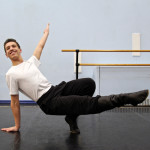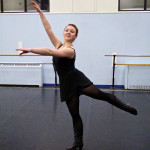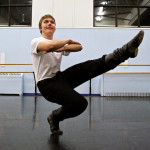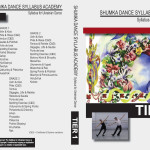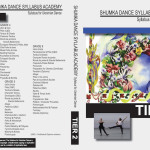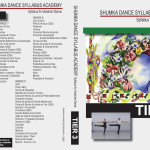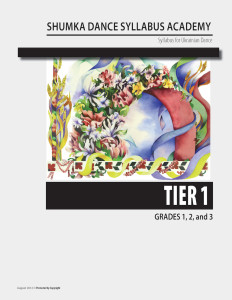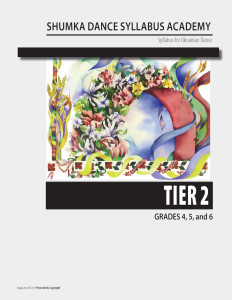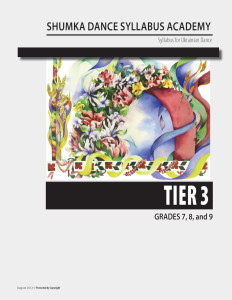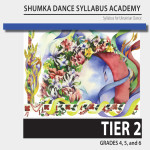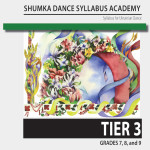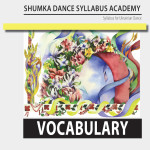Structure
TIER 1
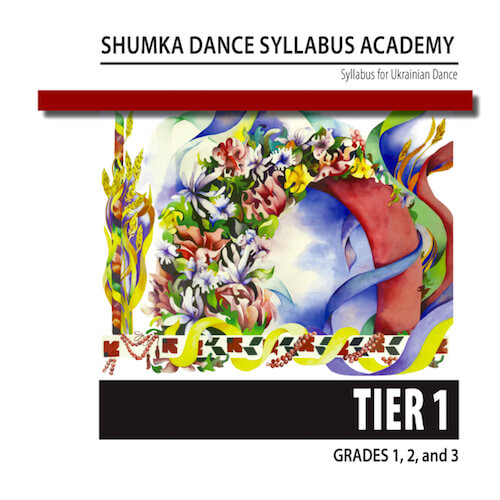
Grade 1
Grade 2
Grade 3
TIER 2
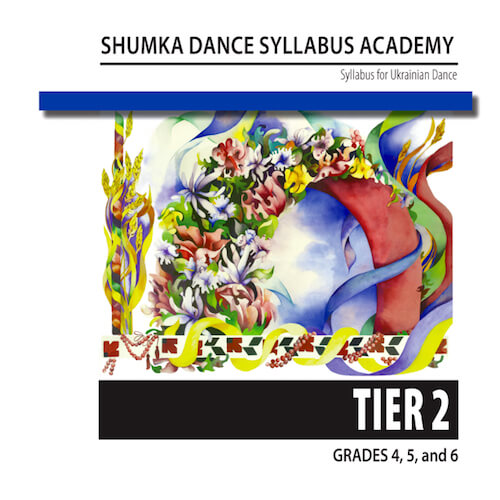
Grade 4
Grade 5
Grade 6
TIER 3
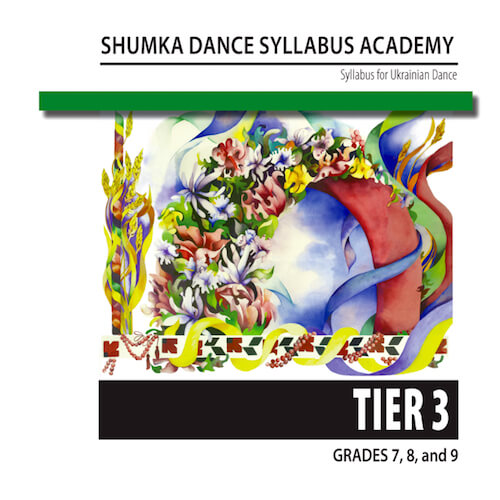
Grade 7
Grade 8
Grade 9
Definition
The Syllabus for Ukrainian Dance is a training program created by Mr. Douglas Rachinski for dancers commencing at age 6, combining the dance disciplines of Ukrainian character and ballet, reflecting the ideals of the Ukrainian Shumka Dancers. Although dancers may study any of the grades at any given pace, the complete syllabus is designed for chronological instruction over a minimum of 9 years, suggesting earliest completion by 15-16 years of age.
Starting in Grade 1 (age 6), students at Shumka School train utilizing the Shumka Syllabus for Ukrainian Dance, which happens in all Core Division classes.
The Syllabus consists of nine grades divided into Certificate and Diploma levels. It is designed for instruction over an average of 10-12 years, since dancers may examine at the certificate level in one year, and then at the diploma level for the same grade in the following year. It is designed in this manner to ensure appropriate progression through the grades.
Syllabus Structure
1. PROCEDURES
2. UKRAINIAN DANCE GLOSSARY
3. MASTER GLOSSARY
4. SET EXERCISES
a) Reverence & Circle
b) Barre
c) Centre
5. GRADE NOTATIONS
6. CLASSICAL BALLET
The syllabus includes customized bayan accompaniment audio and video of each of the 165 exercises comprising the program.
1. PROCEDURES
Due to the scope of the program, the syllabus requires a number of stated procedures to ensure it’s appropriate delivery and governance. In the ‘Procedures’ portion, the user can refer to details on all aspects of program delivery including Instructor and student certification, Academy membership, syllabus workshop and examination offering, Instructor and SDSA roles and responsibilities and related matters.
The Procedures document is retained only by certified Instructors, i.e. those having successfully participated in an instructor exam. Only certified Instructors are permitted to enter students into examinations.
2. UKRAINIAN DANCE GLOSSARY
The ‘Ukrainian Dance Glossary’ includes all terms used in the instruction of Ukrainian dance as delineated in this program. It is recognized there are additional steps and alternative terms for the steps provided (for example, ‘zhaba’ as opposed to ‘mitelochka’.) As well, it is recognized that some terms in this glossary are borrowed from the French or ballet tradition. Insofar as this is concerned, steps such as balance (3 beat lyrical step) or chainé (a ‘chain’ of turns most commonly performed on the toes) are included in the ‘Classical Ballet’ appendices in order to properly assign them to their origin and only the character variations of these steps are included in this glossary.
3. MASTER GLOSSARY
A ‘Master Glossary’ for all Ukrainian dance vocabulary is also provided. Each master glossary lists all applicable dance terms alphabetically according to the example provided above, showing where a step, and in what variation(s), is introduced within the 9 grade program.
4. SET EXERCISES
The set exercises are the core of the syllabus. They are a listing of exercises for each grade in an order suggested for dancer safety and class effectiveness, based on the format of a typical dance class. The program design provides the student with an appropriate sequence of exercises on an appropriate annual timeline.
The Shumka Syllabus is the only Ukrainian dance Syllabus outside of Ukraine that provides this kind of planned progression.
The syllabus is designed to offer as many as 26 set exercises at any one grade level. In order to reduce the load for a typical dancer training 1 – 2 times per week and learning choreography apart from syllabus, set exercises have been divided into ‘CERTIFICATE’ and ‘DIPLOMA’ patterns or routes. Generally speaking, certificate exercises are entry grade level exercises, and diploma exercises are progressed grade level exercises. Although there is some overlap between certificate and diploma exercises (in such case the certificate variation is either a shorter or simpler variation), this division allows the instructor additional flexibility as to the course and pace of instruction, and the student to study a given grade level for more than one year.
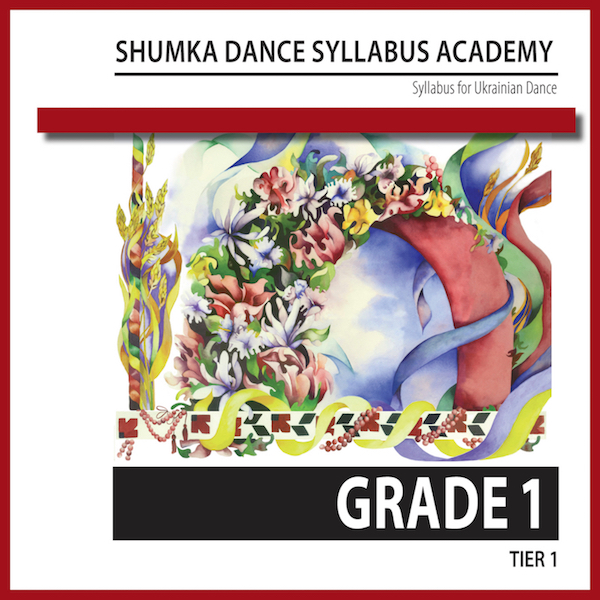
Grade 1
Certificate & Diploma
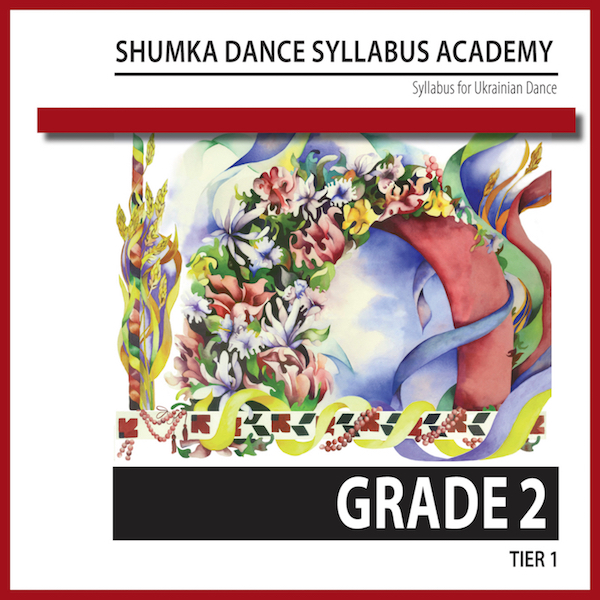 Grade 2 Grade 2
Certificate & Diploma
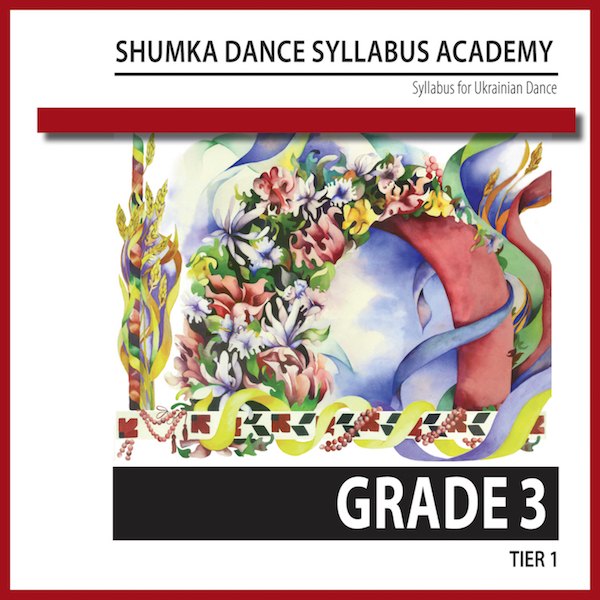
Grade 3
Certificate & Diploma
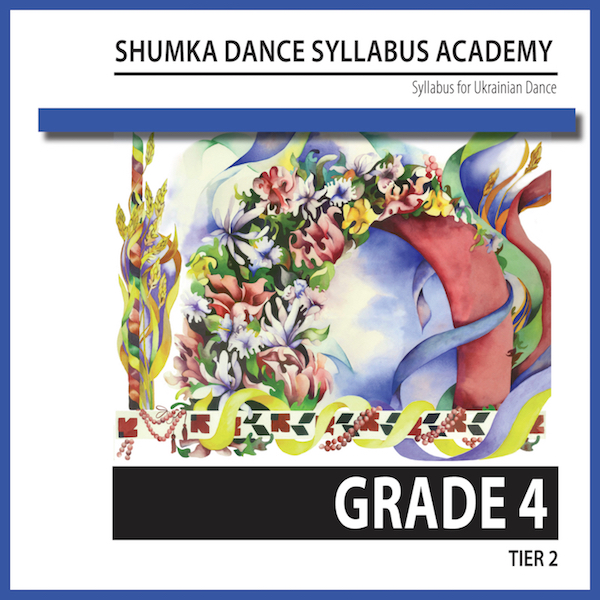
Grade 4
Certificate & Diploma
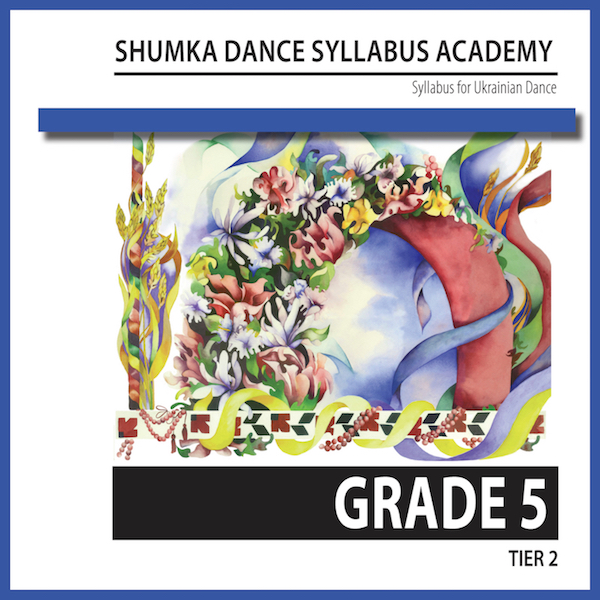
Grade 5
Certificate & Diploma
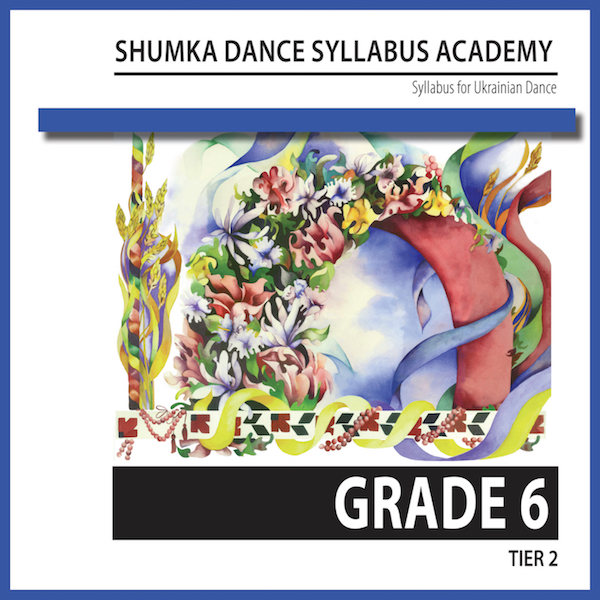
Grade 6
Certificate & Diploma
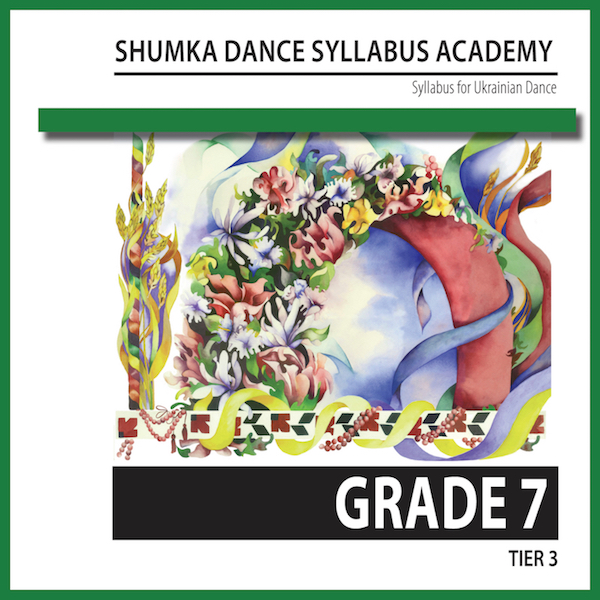
Grade 7
Certificate & Diploma
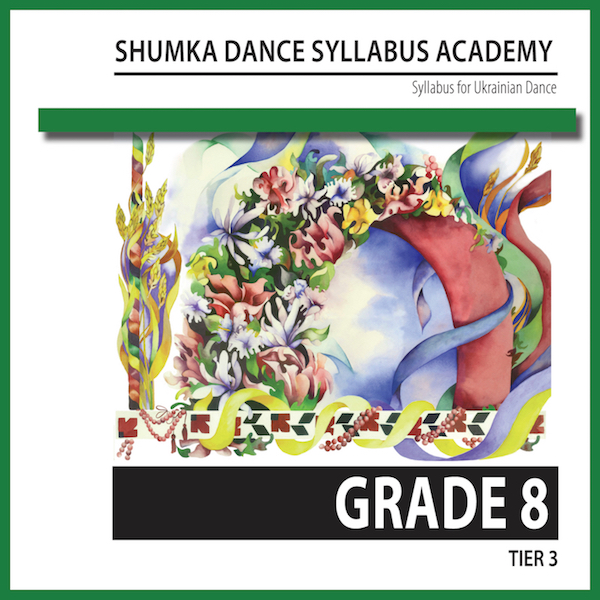
Grade 8
Certificate & Diploma
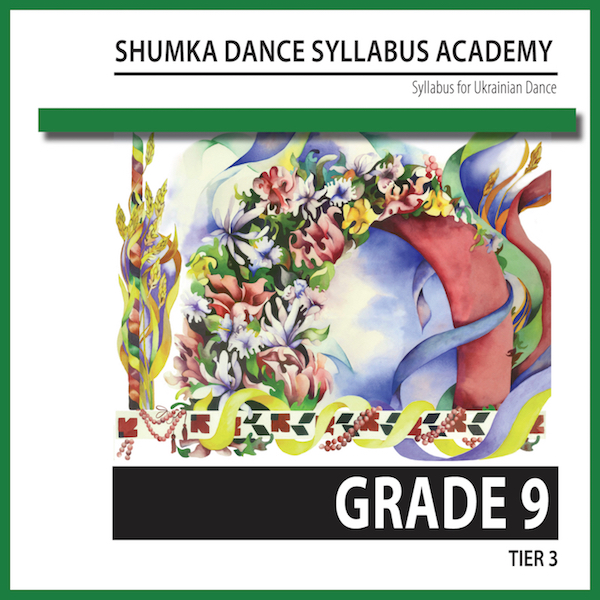
Grade 9
Certificate & Diploma
5. GRADE NOTATIONS
Grade notations are a convenient reference for instructors, describing movements of the body for all exercises on a ‘count by count’ basis. Although notations should be studied and memorized in advance of class instruction, they are referable in the class setting in moments of memory lapse or for points of clarification.
6. CLASSICAL BALLET
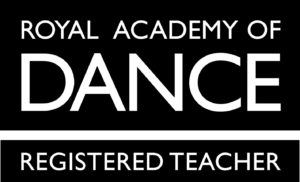 Classical ballet appendices, based on the Royal Academy of Dance (R.A.D.) vocabulary and technique, provide a thorough resource for the user and the basis from which ballet instruction is delivered in the instructor syllabus workshop. Teachers of Ukrainian dance have a varying degree of ballet training and expertise, ranging from certification as ballet instructor or dancer to training obtained through participation in Ukrainian or other dance forms. The classical ballet appendices address all classical ballet vocabulary, positions and poses, technique, anatomy and postural issues associated with, and required for effective instruction of, the set exercise content of the Syllabus for Ukrainian Dance. Classical ballet appendices, based on the Royal Academy of Dance (R.A.D.) vocabulary and technique, provide a thorough resource for the user and the basis from which ballet instruction is delivered in the instructor syllabus workshop. Teachers of Ukrainian dance have a varying degree of ballet training and expertise, ranging from certification as ballet instructor or dancer to training obtained through participation in Ukrainian or other dance forms. The classical ballet appendices address all classical ballet vocabulary, positions and poses, technique, anatomy and postural issues associated with, and required for effective instruction of, the set exercise content of the Syllabus for Ukrainian Dance.
|
|
Students
1st Week of April
Syllabus exam recommendation forms are given out to families in class during the week of April 1 – 5, 2019.
Example Exam Recommendation Form
HOW DO DANCERS GET RECOMMENDED FOR A SYLLABUS EXAM?
Instructors are aware of each dancer’s abilities and are therefore in the best position to advise the family if the dancer is prepared for the examination. To ensure a productive, positive exam experience, instructors recommend Core Program students they believe will be prepared to take the exam. Students in the Intensive Division are required to participate in a syllabus exam and will be automatically recommended. At the beginning of the dance season, it is the Principal who determines if the class will eventually examine in the Certificate or Diploma level. Students then spend the year learning the exercises in the selected certificate or diploma level. In March, it is the instructor who determines if each Core Program dancer will participate in an examination. At the beginning of April, families will receive a form indicating the syllabus examination recommendation. If recommended, the decision to participate for Core Program students is made by the family. Intensive Division students are required to participate in a Syllabus exam.
BACKGROUND
Since 1994, the Ukrainian Shumka Dancers and Shumka Dance Syllabus Academy have placed a high priority on the development and implementation of the Shumka Syllabus for Ukrainian Dance, to ensure proper skill training for generations to come. Shumka School is proud to offer a curriculum-based Ukrainian dance program through the Shumka Syllabus for Ukrainian Dance.
The Syllabus for Ukrainian Dance is a training program created for dancers ages six and over, developed by Mr. Douglas Rachinski with ballet compliment provided by Tasha Orysiuk. Shumka’s Syllabus is intended to enhance the technical execution of Ukrainian dance; contribute to its enjoyment; and promote its continued vision for future generations of Ukrainian dancers, teachers, and enthusiasts. It is a fully researched and developed curriculum program that ensures correct advancement of dance skill and technique, and enhances the dance training process by:
- Offering consistency in training.
- Providing logical progression from one level to the next.
- Standardizing the use of terminology.
- Standardizing the style and technique of steps and exercises.
Throughout the year, dancers follow a pre-determined course of study, including set exercises at the barre, from the corner, and in the centre. These exercises are set to custom-orchestrated music. They complement the learning process and contribute to the overall long-term development of the dancer. Every new exercise and skill learned is like a fresh piece in a puzzle. When the puzzle is complete, a dancer should have the technical skills to work at a high dance level. In this manner, the Syllabus ensures proper growth and critical skill development while providing students with a solid foundation of skills and knowledge.
CURRICULUM OUTLINE
The set exercises are the core of the Syllabus. They are a listing of exercises for each grade in an order suggested for dancer safety and class effectiveness, based on the format of a typical dance class. Although certain steps or exercises could be introduced in different order, the program design provides the student with an appropriate sequence of exercises on an appropriate annual timeline. It is the prerogative of the instructor to alter format, re-order exercises or utilize choreography apart from that offered via the video/written resource to best suit his/her needs or unique class situation. The syllabus is designed to offer as many as 26 set exercises at any one grade level. To reduce the load for a typical dancer training one to two times per week and learning choreography apart from Syllabus, set exercises have been divided into ‘Certificate’ and ‘Diploma’ variations. Certificate exercises are entry grade level exercises, and diploma exercises are progressed grade level exercises. Although there is some overlap between certificate and diploma exercises (in such case the certificate variation is either a shorter or simpler variation), this division allows the instructor additional flexibility as to the course and pace of instruction, and the student to study a given grade level for more than one year. Typically, students will participate in one diploma variation of a Grade per Tier (example, Grade 1, Grade 2, Grade 2 Diploma, and Grade 3).
Below is an example visualizing the differences between the Certificate and Diploma variations, for Grade 1.
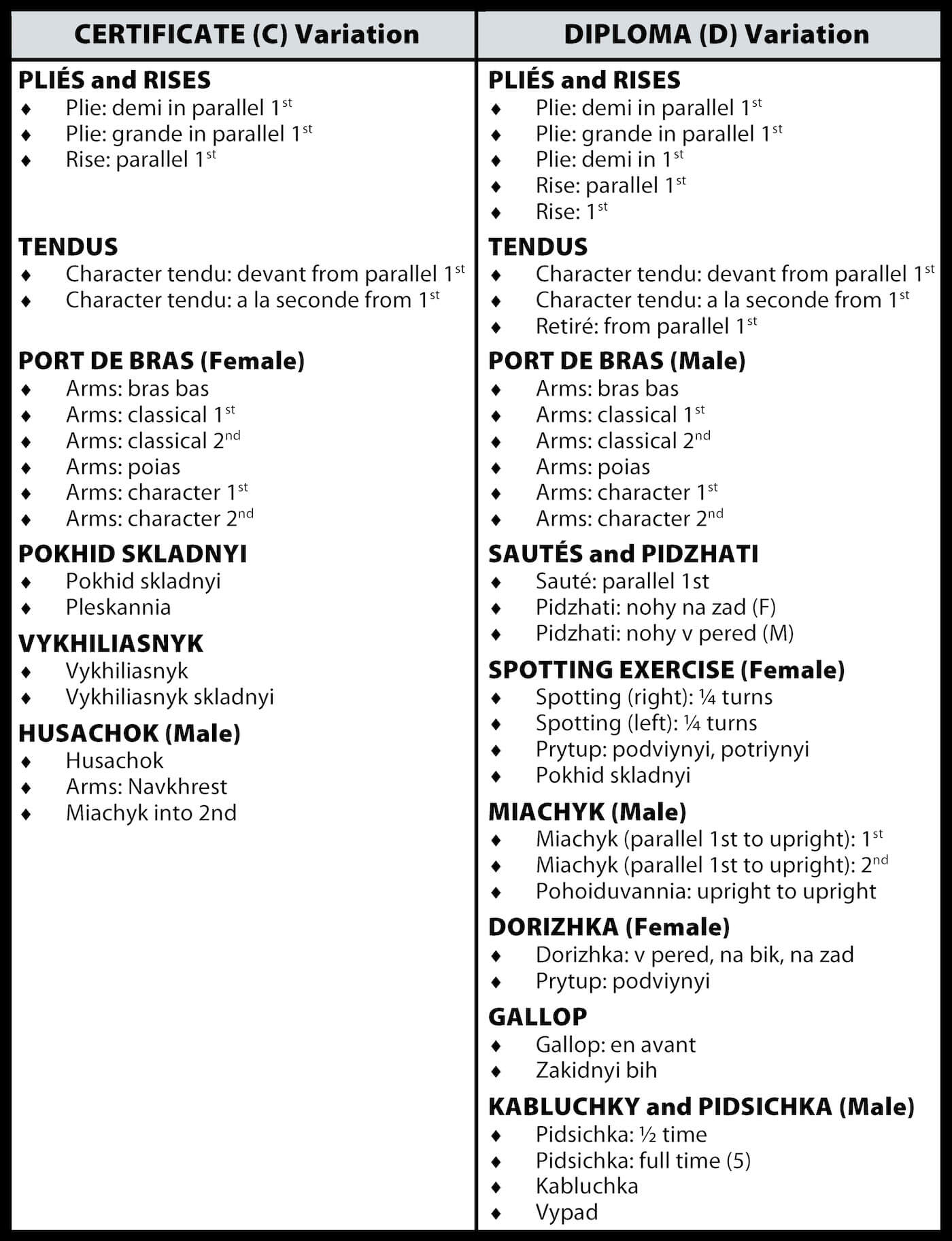
Below is the complete listing of set exercises for each grade in the Shumka Syllabus for Ukrainian Dance:
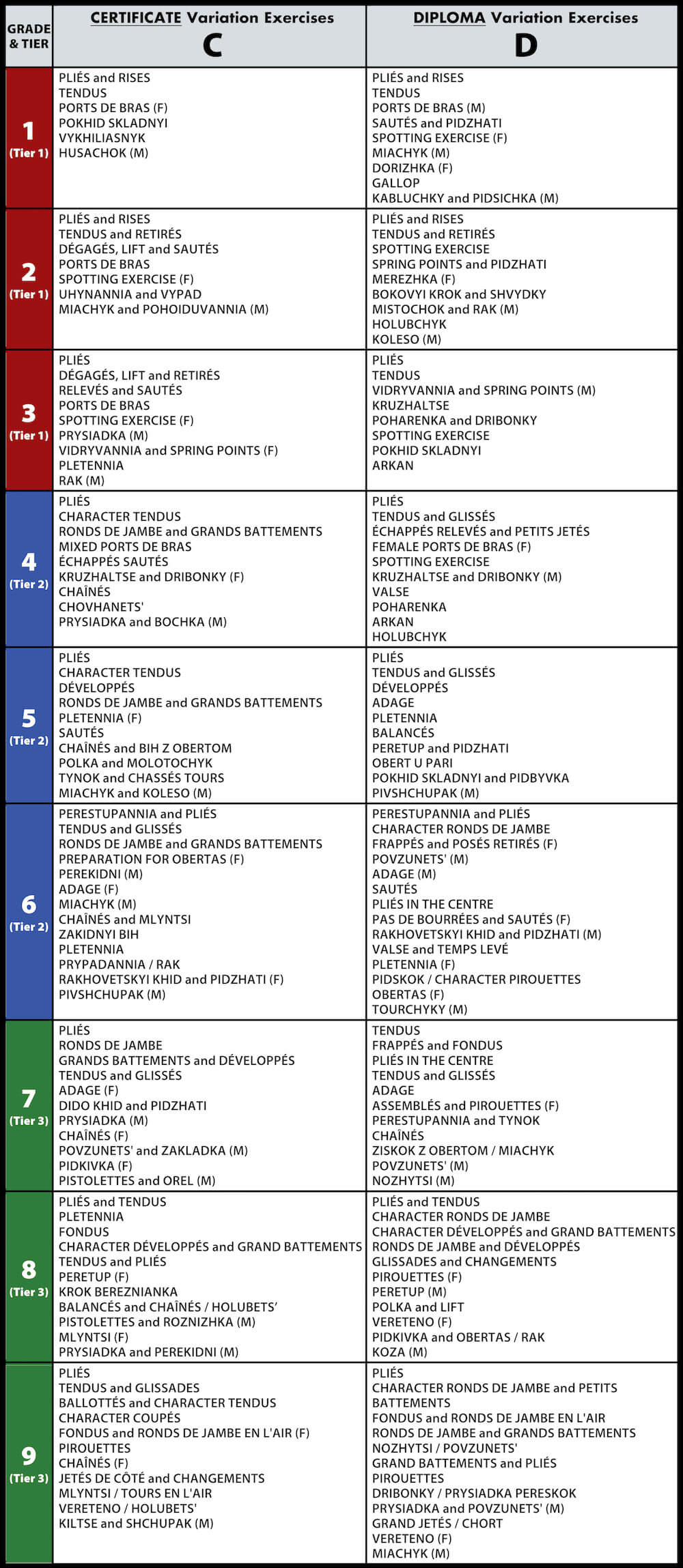
STUDENT SYLLABUS EXAMINATIONS
Independent evaluations are offered annually. Syllabus exam recommendation information is distributed to families during the first week of April. Reference the School Calendar of Dates for the syllabus exam fee payment due date.
EXAM BENEFITS
- Syllabus exams offer a structured, non-threatening third-party assessment of the dancer’s progress and ability, along with encouragement for the mastered skills. Feedback includes specific areas that might still require improvement, along with strategies to improve in these areas.
- Syllabus exams provide a central goal for dancers to work towards.
- Syllabus exams build confidence and provide dancers with a sense of achievement.
- Syllabus exams provide guidance for class placement.
- Syllabus exams provide instructors with valuable feedback about the student’s skills.
HOW DO DANCERS GET RECOMMENDED FOR A SYLLABUS EXAM?
Instructors are aware of each dancer’s abilities and are therefore in the best position to advise the family if the dancer is prepared for the examination. To ensure a productive, positive exam experience, instructors recommend Core Program students they believe will be prepared to take the exam. Students in the Intensive Division are required to participate in a syllabus exam and will be automatically recommended. At the beginning of the dance season, it is the Principal who determines if the class will eventually examine in the Certificate or Diploma level. Students then spend the year learning the exercises in the selected certificate or diploma level. In March, it is the instructor who determines if each Core Program dancer will participate in an examination. At the beginning of April, families will receive a form indicating the syllabus examination recommendation. If recommended, the decision to participate for Core Program students is made by the family. Intensive Division students are required to participate in a Syllabus exam.
AUDIT EXAM
Students who are close to completing a grade level but are not recommended for an exam may be given the opportunity to audit an examination. The student auditing is critiqued in the same manner, but not offered a final grade. Example of an Audit Exam Offer: Young Mr. Peter is showing good progress in his barre work; however, he needs a bit more work on musicality, centre combinations and presentation. Although he is progressing, it would not be to his benefit for Mr. Peter to participate in a graded exam this year. Instead, Mr. Peter will be offered the chance to audit the exam, where he is critiqued in the same manner, but not offered a final grade. Audit exam offers can be adjusted to an offer by the end of the year if the dancer continues to work hard.
EXAMINATION PROTOCOL
UNIFORM: Core Ukrainian rehearsal attire and footwear (the instructor will clarify exact footwear). Hair must be in a performance bun. No watches or jewelry. Dancers will not be able to examine unless this is followed. No make-up is required.
ARRIVAL: Arrive 30 to 60 minutes prior to the exam (arrival time is determined by the instructor of the class and is needed to rehearse the exercises prior to the exam).
PROCESS: Each exam group consists of a maximum of four students. Dancers enter the studio with a name tag pinned to the bodysuit or shirt, in an established group, and assemble in front of the Examiner. Following the assembly, the dancers are welcomed by the Examiner and repeat back the provided greeting. For example, the Examiner says: “Good evening dancers.” The dancers reply, coordinated with Uklin (bow/curtsy): “Good evening Mrs. or Mr. Examiner.” The Examiner then has the opportunity for a small chat that typically includes words of encouragement for the dancers. The exam concludes with the Examiner asking for the dancers to re-assemble in the entry formation and thanking them for the efforts. For example, the Examiner says: “Thank you dancers, I enjoyed watching you dance today.” The students verbally reply, coupled with Uklin (bow/curtsy): “Thank you Mrs. or Mr. Examiner.” This process is reviewed prior to the exams.
ETIQUETTE: There is absolutely no talking or sitting during an exam. Please keep eyes toward the Examiner and off the mirrors. During the exam, the Examiner will ask the dancers to practice the next exercise.
EXAM LENGTHS & FEES
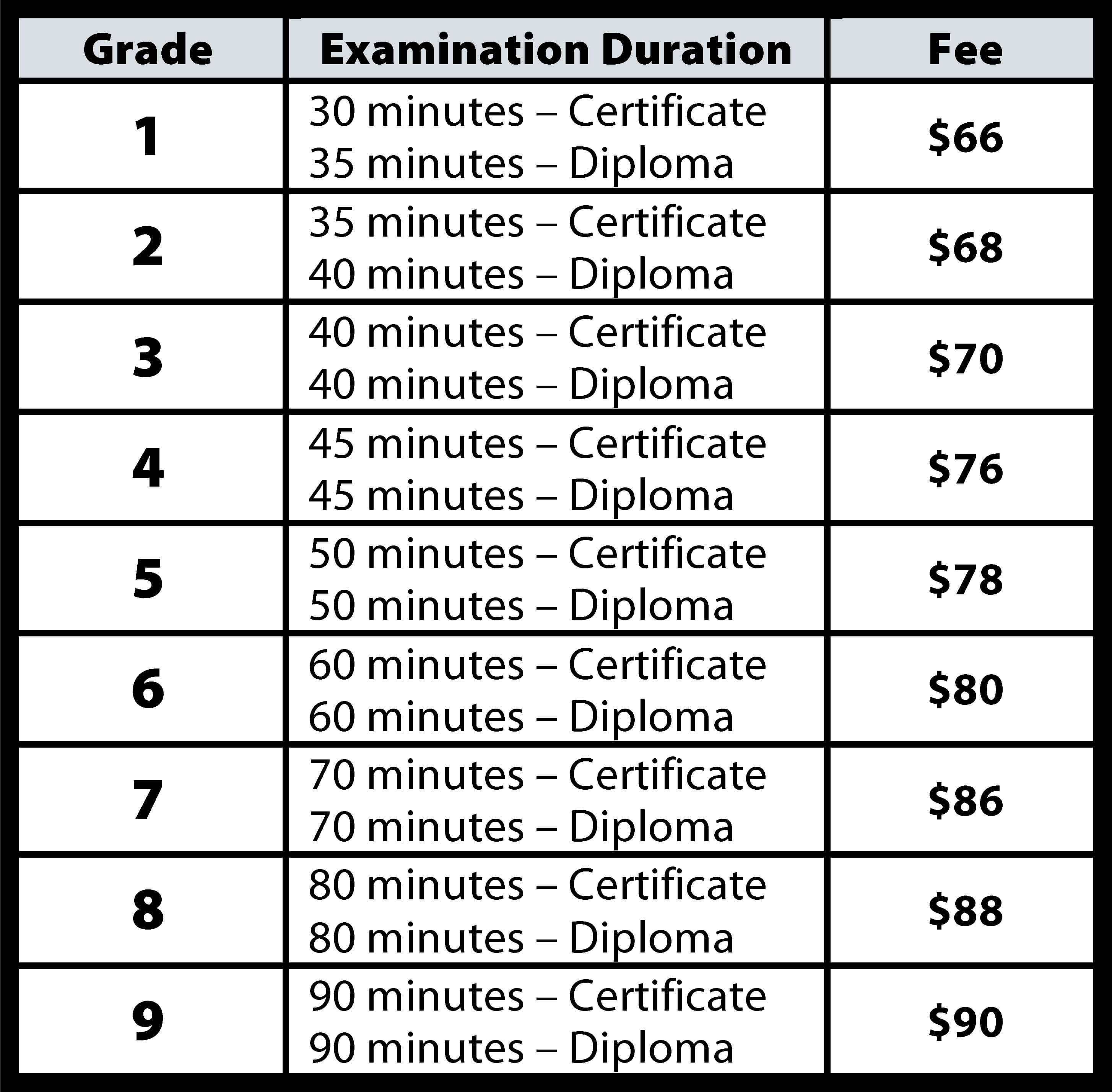
GRADING
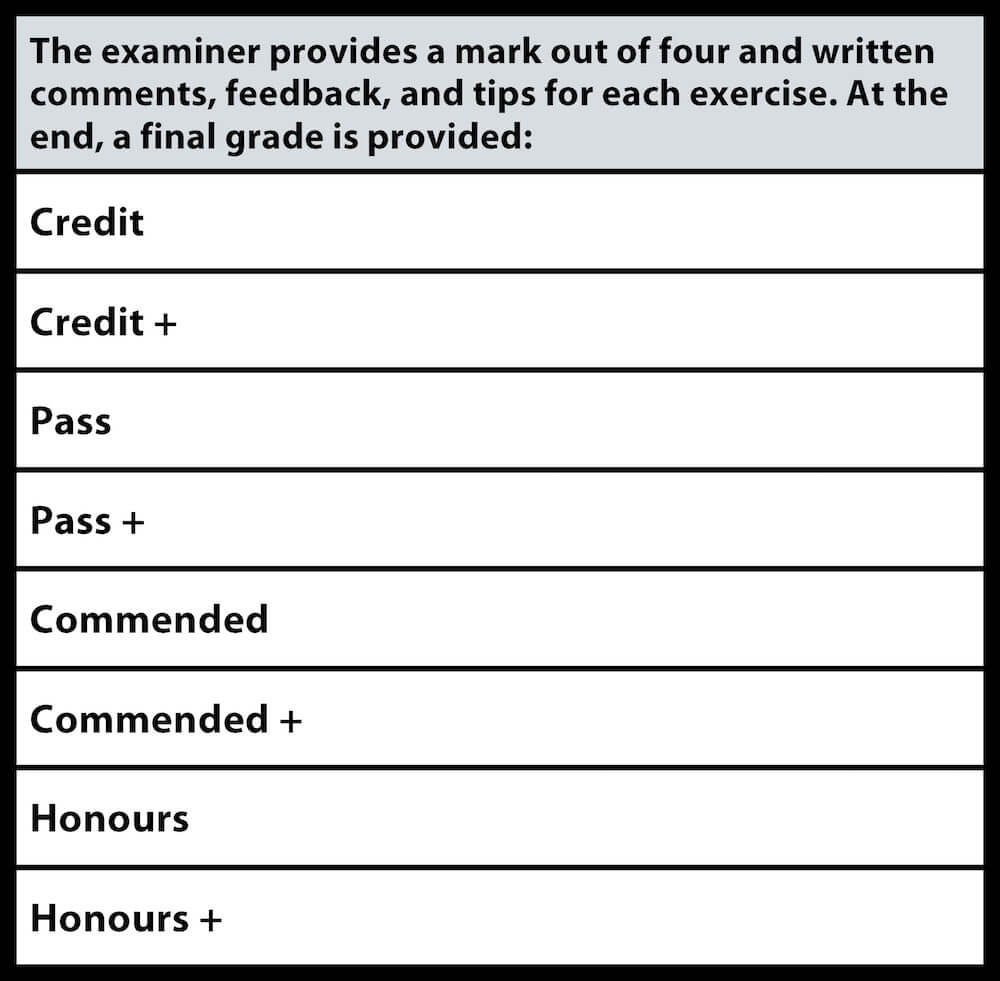
Shown below are example templates of a student syllabus exam, certificates of achievement (for successful completion of a syllabus exam), and graduation diploma (for successful completion of the program):
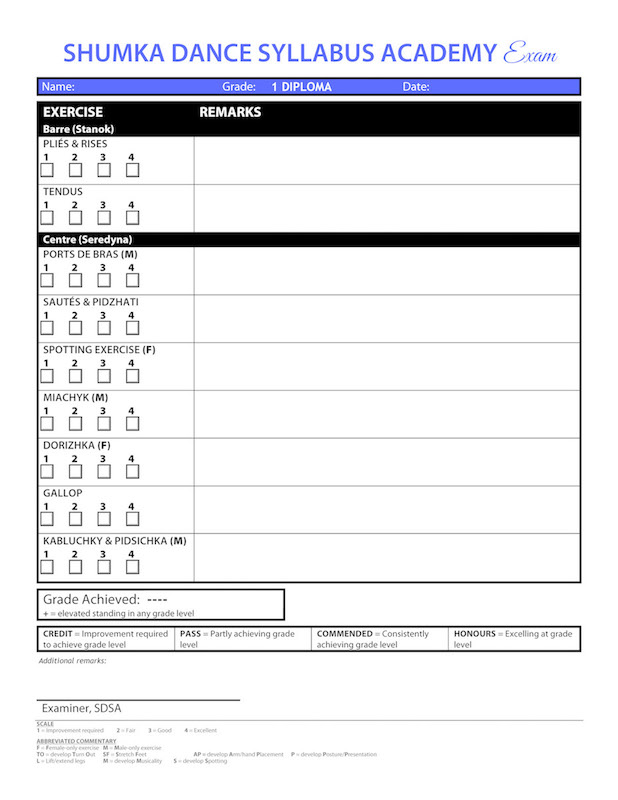
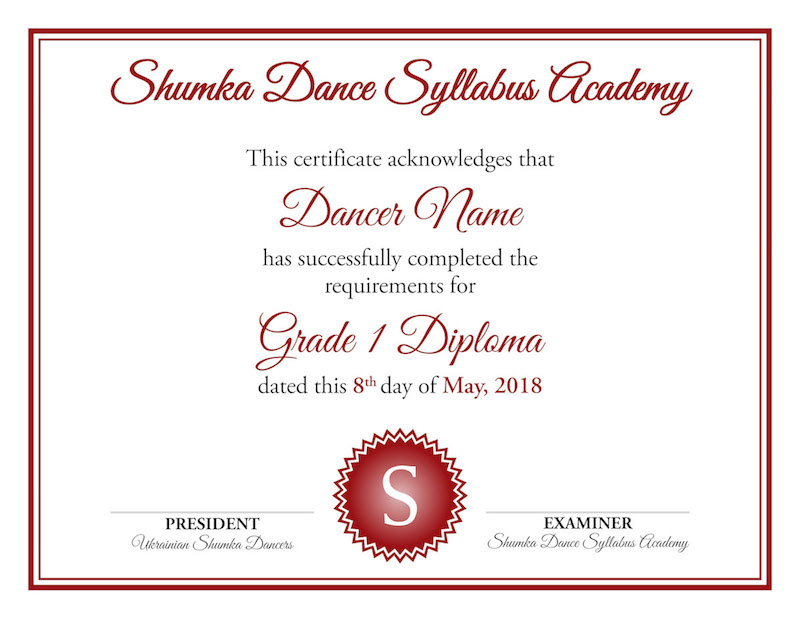  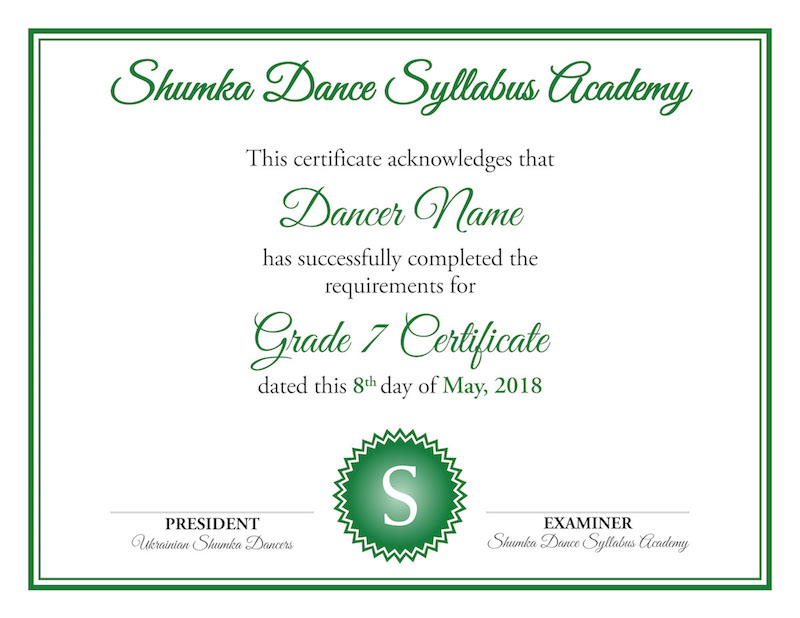 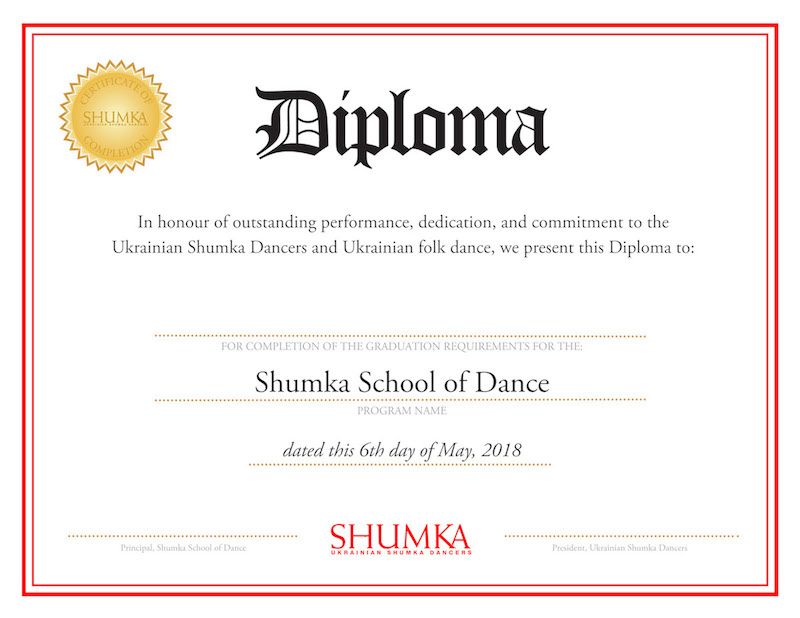
|
|
Instructors
2019 Workshops
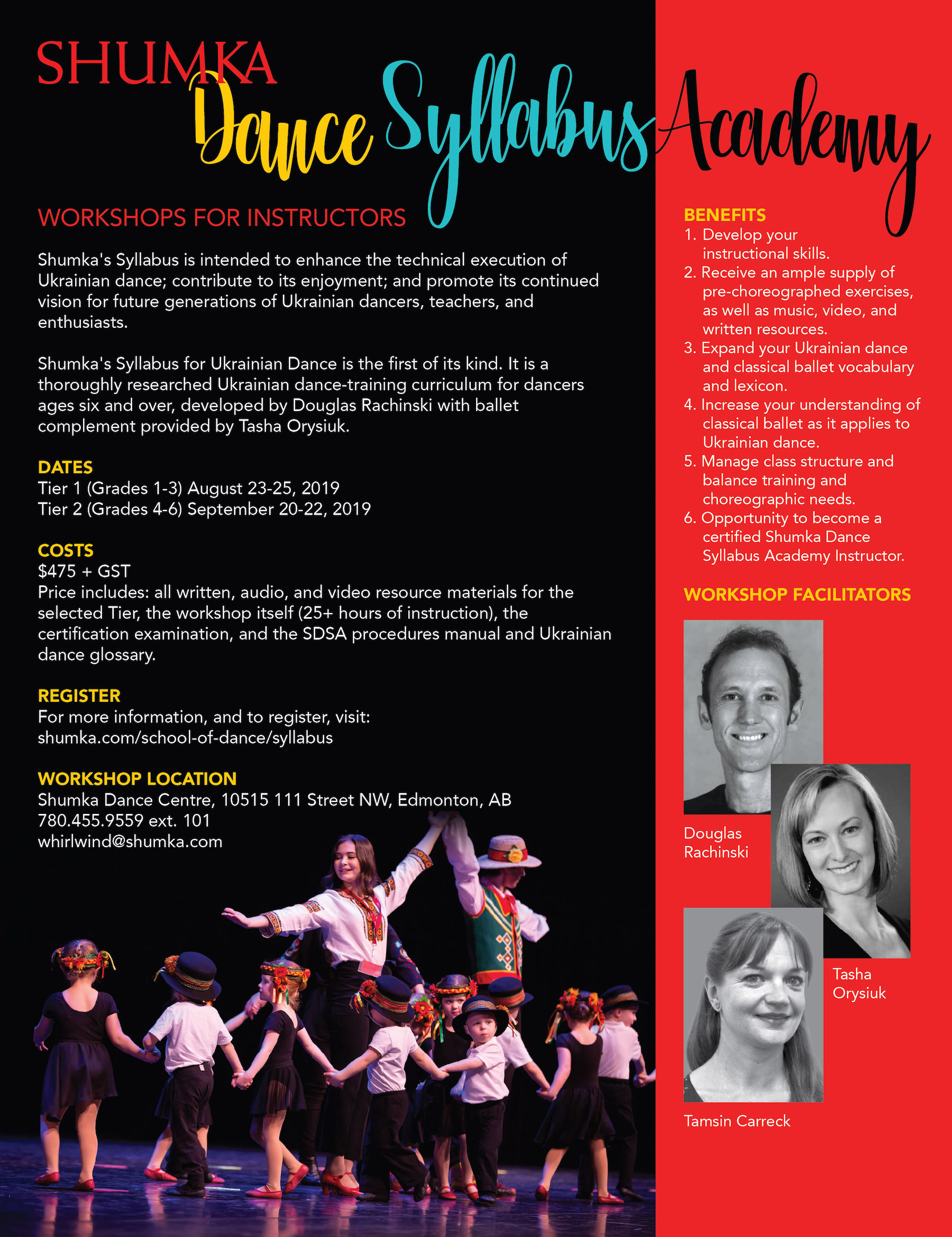
Price includes:
*Price includes:
- All resource materials for the selected Tier.
- The workshop itself (approximately 25+ hours of instruction per workshop).
- SDSA Procedures Manual.
- Ukrainian Dance Glossary.
- Resource booklets, includes the set exercises, grade notations, and classical ballet appendix.
- Digital copies of the musical & video resources (music received on first day of the workshop, videos sent with written materials).
- Instructor exam.
A 50% deposit is required at registration.
All workshops are held in Edmonton at the Shumka Dance Centre (10515 111 Street NW, Edmonton, Alberta)
Benefits
- Develop your instructional skills.
- Receive an ample supply of pre-choreographed exercises, as well as music, video, and written resources.
- Expand your Ukrainian dance and classical ballet vocabulary and lexicon.
- Increase your understanding of classical ballet as it applies to Ukrainian dance.
- Manage class structure and balance training and choreographic needs.
- Opportunity to become a certified Instructor with Shumka Dance Syllabus Academy.
NOTE: Instructors must progress in Tier order (from Tier 1 through to Tier 3).
Features
- Extensive Ukrainian dance and classical ballet vocabularies with prescribed techniques.
- Set exercises in kolo, barre, centre, and corner, providing instructors and students with an ample supply of ready-made content.
- Examinations give students the opportunity to be evaluated by a qualified examiner of the Academy.
- Customized video & musical arrangements for all set exercises.
- Syllabus workshops, whereby instructors are trained in syllabus content and teaching strategies for their ongoing professional development and successful implementation of the program.
- Instructor examinations held in conjunction with workshops, whereby instructors are provided opportunity to certify as instructors of the Syllabus Academy.
Notes
PRIOR TO THE WORKSHOP, instructors should have basic knowledge of the set exercises & vocabulary for the tier in which they are enrolled.
AT THE CONCLUSION OF THE WORKSHOP, participants are encouraged to enroll in an instructor exam in order to become a certified Shumka Syllabus Instructor.
WHEN PAYMENT IS RECEIVED, all resource items will be mailed to participants living outside of Edmonton, AB. For participants living in Edmonton, when payment is received, your materials will be available for pickup in the main office at the Shumka Dance Centre.
Music received on first day of the workshop, videos sent with written materials. Please remember to bring your Shumka Syllabus USB Card(s) to the workshop in order to receive the music.
What should I bring?
- Your Shumka Syllabus USB Card(s)
- Dance attire, including footwear
- Notebook, tablet, or laptop
- Something to write with (if desired)
Your syllabus resource manuals
Payment
A 50% deposit is required at registration. Please direct all payments to the Shumka General Office.
June Eeles: 780.455.9559 ext. 101
We accept VISA/MasterCard over the phone, and debit, cash, or cheque in person at the Shumka General Office.
Cheques can be made payable to Ukrainian Shumka Dancers, and mailed to:
Ukrainian Shumka Dancers
10515 111 Street NW
Edmonton, AB T5H 3E8
Online Registration
|
|
Materials
Video – Audio – Written
The syllabus prides itself on custom designed musical accompaniment, video display, and written notations of each of the set exercises found in the program. Users will discover that additional music is provided in various centre exercises to promote class flow, i.e. where a group repeats an exercise or subsequent groups of dancers perform the same exercise.
Video Reference
Exercise Manuals
User Guides
-

-
User Guide WORKSHOP Edition
-

-
User Guide CERTIFIED Edition
Music Reference
|
|













 Classical ballet appendices, based on the Royal Academy of Dance (R.A.D.) vocabulary and technique, provide a thorough resource for the user and the basis from which ballet instruction is delivered in the instructor syllabus workshop. Teachers of Ukrainian dance have a varying degree of ballet training and expertise, ranging from certification as ballet instructor or dancer to training obtained through participation in Ukrainian or other dance forms. The classical ballet appendices address all classical ballet vocabulary, positions and poses, technique, anatomy and postural issues associated with, and required for effective instruction of, the set exercise content of the Syllabus for Ukrainian Dance.
Classical ballet appendices, based on the Royal Academy of Dance (R.A.D.) vocabulary and technique, provide a thorough resource for the user and the basis from which ballet instruction is delivered in the instructor syllabus workshop. Teachers of Ukrainian dance have a varying degree of ballet training and expertise, ranging from certification as ballet instructor or dancer to training obtained through participation in Ukrainian or other dance forms. The classical ballet appendices address all classical ballet vocabulary, positions and poses, technique, anatomy and postural issues associated with, and required for effective instruction of, the set exercise content of the Syllabus for Ukrainian Dance.